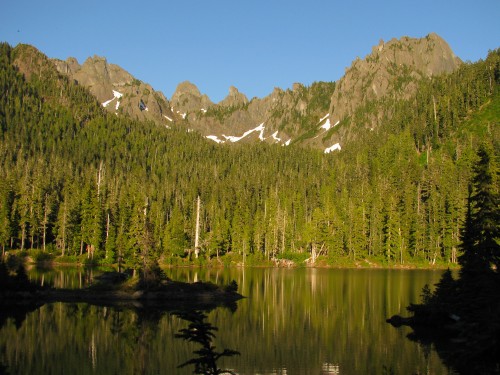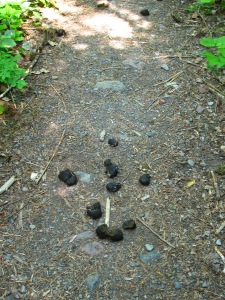I’ve seen a bit of the interior West lately. The middle of March found me finishing up wolverine work in the North Cascades of Washington state. By early April, I had performed the reverse-migration of driving south to the Sacramento Mountains of southern New Mexico. To put it another way—I used to be 60 miles from the Canadian border, and I now find myself a hundred miles or so from Mexico.
To my surprise and chagrin, however, driving 2,000 miles southward has somehow pushed me backward into winter. Warm, sunny days in Washington and the balsamroot beginning to bloom, yet leftover snowbanks in New Mexico, sleet, and yes, yesterday morning—snow flurries.
I suppose the elevation might have something to do with it. The Methow Valley sits at about 1800’, whereas Cloudcroft soars at 8650’. But still, it seems a little strange.
One of the pleasures of the desert southwest, though, is your ability to move. A 16 mile drive out of Cloudcroft drops one more than 4000’ into Alamogordo and the Chihuahuan Desert. Twelve miles south of Alamogordo is a quiet little piece of heaven called Oliver Lee Memorial State Park.
The park is nestled against the escarpment of the Sacramento Mountains, 12 miles south of Alamogordo, NM. There is something about the location—maybe it is the water flowing out of Dog Canyon—that seems to concentrate bird, animal, and plant life. On this day, sporadic rain scattered down on the park as heavy clouds lowered veils of rain down on the escarpment. It was beautiful and much better than sitting through the 4-6” of snow that was falling up top. And the birds were singing.
By far the highlight of the day was wandering down the wash below the visitor center and catching two good looks at a male red-faced warbler in full breeding plumage. Not a common bird around these parts, and a striking bird.
Want a bird list? Here you go:
Oliver Lee Memorial State Park, April 23-24, 2010
Turkey vulture red-tailed hawk
Sharp-shinned hawk white-winged dove
Mourning dove great-horned owl
White-throated swift black-chinned hummingbird
Broad-tailed hummingbird ladder-backed woodpecker
Say’s phoebe western kingbird
Violet-green swallow Chihuahuan raven
Verdin cactus wren
Rock wren canyon wren
Ruby-crowned kinglet blue-gray gnatcatcher
American robin curve-billed thrasher
Warbling vireo black-throated gray warbler
Orange crowned warbler Virginia’s warbler
Yellow-rumped warbler Townsend’s warbler
American redstart Wilson’s warbler
Red-faced warbler western tanager
Spotted towhee canyon towhee
Chipping sparrow black-throated sparrow
White-crowned sparrow western meadowlark
Scott’s oriole house finch
The second day at Oliver Lee was the hike up Dog Canyon, which I highly recommend. You get up into a canyon with high walls, and another watery section of canyon bottom just below where the canyon boxes out. Pretty there, with dripping water and maidenhair fern. I was hoping to find one of those places… you know, the pool-sized plunge pool below the pouroff… the place to ask a girl to marry you. But no luck. The hike is good though. You pass through several different ecological zones as you gain elevation, and get views of the desert and White Sands.
Oh yeah, and it is a historical spot. The visitor center is beside the ruins of a homesteader named “Frenchy” Rochas (1843-1894) who died under mysterious circumstances and did some impressive work with stone walls and irrigation. Nearby, too is the ranch house of Oliver Lee (1865-1941), a locally famous rancher and politician who even had a run-in with Pat Garrett. The book Tularosa is a good read about local history.
But all things must end. By the end of the weekend it was back up into winter at nearly 9000’. Someday soon the trees will leaf out, and it won’t be long until the mountain will be a pleasantly cool refuge from the blistering heat of the desert floor.






























 And apparently the money gets put to good use. The North Fork Skokomish trail, which I followed for 4 miles before departing upward toward the high country, is a highway. Two horses could pass by each other without even touching with a flash of tail. And apparently they do. Within minutes of taking to the trail, i was dodging gooey gems of horsiness all along the trail. At least the smell drifts around enough that you usually get a warning to look down before a squishy encounter. People, of course, have to bury their shit at least 6 inches deep and 200 feet from a water’s edge. But the horses have no such restrictions in the park. No diapers needed. Hikers beware. Noble beasts, smelly effluent.
And apparently the money gets put to good use. The North Fork Skokomish trail, which I followed for 4 miles before departing upward toward the high country, is a highway. Two horses could pass by each other without even touching with a flash of tail. And apparently they do. Within minutes of taking to the trail, i was dodging gooey gems of horsiness all along the trail. At least the smell drifts around enough that you usually get a warning to look down before a squishy encounter. People, of course, have to bury their shit at least 6 inches deep and 200 feet from a water’s edge. But the horses have no such restrictions in the park. No diapers needed. Hikers beware. Noble beasts, smelly effluent.
 The lowland forests of western Washington are cloaked in life. Heavy moss hangs from bigleaf maples. Huge trunks send branches into the heavens to shade out the lower creatures. Ferns and moss everywhere. There’s not a place where sunlight hits bare ground. Except of course for this trampled trail worn down to rock and dry dirt. But the world changes with each step upward.
The lowland forests of western Washington are cloaked in life. Heavy moss hangs from bigleaf maples. Huge trunks send branches into the heavens to shade out the lower creatures. Ferns and moss everywhere. There’s not a place where sunlight hits bare ground. Except of course for this trampled trail worn down to rock and dry dirt. But the world changes with each step upward.


